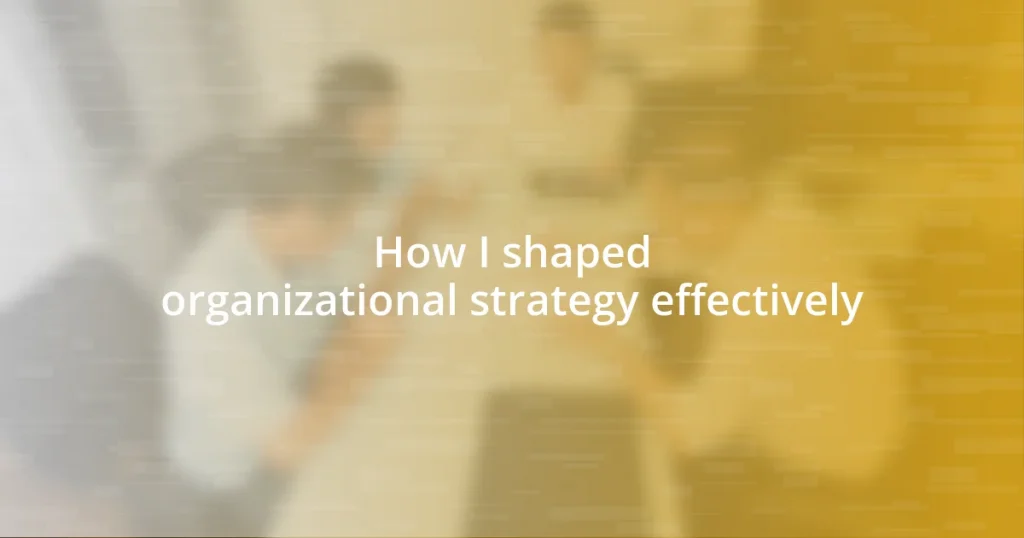Key takeaways:
- Effective organizational strategy requires clarity, alignment of goals with core values, and actionable steps to foster teamwork and ownership.
- Engaging stakeholders in the strategy development process enhances collaboration, builds trust, and maintains momentum through continuous communication.
- Regular monitoring and adaptability are crucial for successful strategy implementation, ensuring that teams can respond effectively to challenges and celebrate progress.

Understanding organizational strategy
Understanding organizational strategy is like navigating a complex but intriguing maze. It involves the careful alignment of a company’s vision, mission, and goals with the actions required to achieve them. When I first stepped into the realm of strategy formulation, I was amazed by how impactful a well-defined strategy could be on every level of an organization.
Have you ever felt like you were in a race without a finish line? Without a clear organizational strategy, that’s precisely what I experienced. During a critical project, the lack of direction led to frustration and inefficiency among the team. It was in that moment I realized how essential it is for every individual to understand their role within the larger framework. This insight transformed my approach to strategy, emphasizing clarity and communication.
I’ve found that an effective organizational strategy is not just about high-level goals; it’s about translating those goals into actionable steps for every employee. When I worked closely with my team to craft a strategy, I witnessed the way it blossomed into a collective effort, sparked by excitement and ownership. Suddenly, everyone was inspired to contribute, reinforcing that a shared understanding is not just beneficial—it’s crucial for success.

Identifying key organizational goals
Identifying key organizational goals is often the first critical step in shaping an effective strategy. Early in my career, I remember working for a company that struggled with conflicting priorities. Each department had its own set of goals that rarely aligned. This disarray made it difficult for us to make significant progress. Through this experience, I learned that aligning organizational goals requires thorough discussions and insights from various stakeholders to ensure everyone is on the same page.
Moreover, the process isn’t merely about listing desirable outcomes; it’s also about understanding the organization’s core mission and values. I recall a pivotal meeting where we collectively revisited our company’s mission statement. Taking the time to reflect helped redefine our main objectives. By anchoring our goals in our core values, we not only fostered a greater sense of purpose but also motivated team members to strive for these shared aspirations. This collaborative approach birthed a clearer direction and instilled a deeper commitment among the team.
Lastly, when identifying organizational goals, prioritization is key. I learned this lesson during a particularly chaotic quarter when we had too many objectives on our plates. We had to sit down together and evaluate what truly mattered. By ranking our goals based on their impact and feasibility, we directed our efforts where they would yield the best results. It was empowering to focus our collective energy, and witnessing the clarity this brought was a game changer.
| Aspect | Description |
|---|---|
| Alignment | Ensuring all departments work towards common objectives to avoid conflicts. |
| Core Values | Aligning goals with the company’s mission to foster commitment and motivation. |
| Prioritization | Focusing on the most impactful and feasible goals for maximum effectiveness. |

Analyzing market and internal factors
Analyzing market and internal factors is foundational to shaping an organizational strategy. I remember the moment when I was tasked with assessing both the market and our internal capabilities during a strategic shift. Diving into market trends, something stirred in me. It wasn’t just about numbers; I could almost feel the pulse of the industry. Understanding customer needs and competitor movements was like uncovering hidden treasures. I engaged my team by creating an open forum, encouraging them to share their insights. It was enlightening how diverse perspectives helped paint a fuller picture of our position in the market.
When evaluating these factors, several key elements come into play:
– Market Trends: Understanding shifts in consumer preferences and industry dynamics.
– Competitor Analysis: Regularly assessing competitors’ strengths and weaknesses to identify opportunities.
– Internal Capabilities: Evaluating our resources, skills, and limitations to determine what’s feasible.
– SWOT Analysis: Conducting a comprehensive analysis of strengths, weaknesses, opportunities, and threats to guide strategic planning.
– Stakeholder Feedback: Gathering input from employees, customers, and partners to align decisions.
I distinctly remember using a SWOT analysis during a particularly challenging project. It was a revelation to see how our strengths could be leveraged against market opportunities. This collective exploration not only engaged the team but also fostered a sense of ownership in our strategic direction. By genuinely acknowledging the internal factors alongside existing market conditions, we could adapt and drive meaningful results.

Engaging stakeholders in strategy
Engaging stakeholders in the strategy development process is essential for generating buy-in and fostering collaboration. I recall a time when I organized a series of workshops, inviting representatives from all departments. Throughout these sessions, I emphasized the importance of each voice, encouraging team members to share their unique perspectives. The energy in the room shifted dramatically; it was no longer just a meeting—everyone felt a sense of ownership. Isn’t it amazing how, when people are genuinely involved, they become more invested in the outcomes?
What I found crucial was creating safe spaces for honest discussions. I remember one participant hesitated to voice her concerns about our proposed strategy, fearing backlash. But during a breakout session, I noticed how her insights sparked a wider conversation. By facilitating an environment where vulnerability was welcomed, we uncovered challenges we might have overlooked otherwise. I learned firsthand that openness not only builds trust but leads to more robust strategies.
Moreover, following up with stakeholders post-engagement is vital to maintain momentum. I once sent out a summary of our workshop discussions along with actionable items. The feedback I received was heartwarming, as many felt their contributions were valued and considered. It reinforced my belief that ongoing dialogue isn’t just a formality; it’s a lifeline that keeps us connected and focused as we move forward. How many times have we seen strategies fail due to lack of communication? Engaging stakeholders means committing to transparency even after the discussions end.

Developing a clear action plan
Developing a clear action plan is where strategy crystallizes into tangible steps. I vividly remember sitting down with my team, whiteboards covered in ideas that felt overwhelming at first. Yet, as we began to outline priorities, tasks, and timelines, a sense of clarity washed over us. Breaking down lofty goals into manageable actions not only alleviated anxiety but also made it easier for everyone to see their role in the bigger picture.
One technique I found quite effective was employing the SMART criteria—Specific, Measurable, Achievable, Relevant, and Time-bound goals. In one of our projects aimed at improving customer retention, we set a SMART goal to increase our retention rate by 15% within six months. I can still recall the energy in the room when we nailed down the specific strategies: targeted email campaigns, personalized offers, and customer feedback loops. It was a lightbulb moment as everyone understood how these actions were interlinked and vital for our success. Have you ever experienced that satisfaction when a plan comes together so seamlessly?
As we moved forward with the action plan, regular check-ins became a staple of our process. I noticed that holding brief weekly meetings not only kept everyone accountable but also fostered a supportive team culture. It was during one such meeting that a colleague shared some struggles with her assigned tasks. Rather than viewing this as a setback, we brainstormed together and reshaped her workload. The relief she felt was palpable; our action plan transformed from a rigid structure into a living framework that adapted to our needs. Isn’t it amazing how flexibility within a clear plan can lead to greater engagement and problem-solving?

Implementing strategy effectively
Implementing strategy effectively hinges on clear communication and the right tools. I remember a pivotal moment when our team adopted project management software to track our progress. Suddenly, everyone had visibility into tasks, deadlines, and each other’s contributions. Have you ever felt the relief of knowing exactly where things stand? That transparency made accountability feel less like a chore and more like a shared mission.
As we started executing our strategy, I emphasized the importance of adapting to challenges quickly. There was one project where unexpected market changes threatened our original plan. Instead of panicking, we gathered around the table, analyzed the situation, and adjusted our approach. I still recall the tension dissipating as we collaborated on new solutions. Isn’t it incredible how a shared challenge can bring a team closer together?
Ultimately, celebrating small wins along the way became a cornerstone of our success. After completing key milestones, I would often treat the team to lunch as a way to acknowledge their hard work. Those moments not only boosted morale but reinforced our collective commitment to the strategy. Why do we often overlook the power of recognition when implementing plans? A simple act of celebration can transform a daunting journey into an enjoyable one.

Monitoring progress and adapting strategy
Monitoring progress is like keeping your finger on the pulse of your strategy. I vividly recall a time when we integrated a dashboard tool that allowed us to visualize our key performance indicators. It wasn’t just about numbers; seeing data in real-time created a collective sense of urgency and excitement. Have you ever watched a plan come to life through data? It transforms the abstract into something tangible, anchoring our efforts in reality.
As we closely monitored our progress, I discovered the power of feedback loops. During one quarterly review, team members shared insights that led us to pivot our marketing approach mid-campaign. While it felt daunting at first, recognizing the need for change was invigorating. It reminded me that strategy is not a set-it-and-forget-it endeavor but rather a dynamic journey. How often do you pause to listen, recalibrate, and chart a new course? Taking those moments to reflect can be enlightening.
Adapting our strategy wasn’t always seamless, but I felt a sense of camaraderie every time we tackled challenges together. A memorable instance was when a significant competitor launched a surprising new product. Instead of remaining fixed in our approach, we rallied as a team, dissected their move, and redefined our value proposition. That collaborative energy transformed what could have been a setback into an opportunity for growth. Isn’t it refreshing to realize that adaptability can fuel innovation rather than hinder it?















